HEALT2114 Assignment: Indigenous Health and Closing the Gap
VerifiedAdded on 2023/06/04
|9
|2146
|78
Essay
AI Summary
This essay examines the state of Indigenous health in Australia, focusing on the critical issue of life expectancy and the government's Closing the Gap initiative. The introduction highlights the significant disparity in life expectancy between Indigenous and non-Indigenous Australians, emphasizing the importance of addressing this gap. The body of the essay delves into whether the target of closing the gap by 2031 is on track, supported by statistical data on life expectancies and mortality rates. It analyzes various factors influencing the progress, including housing, immunization, substance misuse, and lifestyle choices. The essay discusses strategies implemented by the Australian government, such as improving remote housing, increasing immunization coverage, reducing substance misuse, and promoting healthy lifestyles through sports and nutrition programs. Furthermore, it suggests a collaborative approach between the government and Indigenous communities, particularly through funding the Aboriginal Community Controlled Health sector. The conclusion reiterates the existing gap in life expectancy and underscores the need for collective efforts to achieve the target of closing the gap by 2031, emphasizing the importance of partnership and support for Indigenous communities.
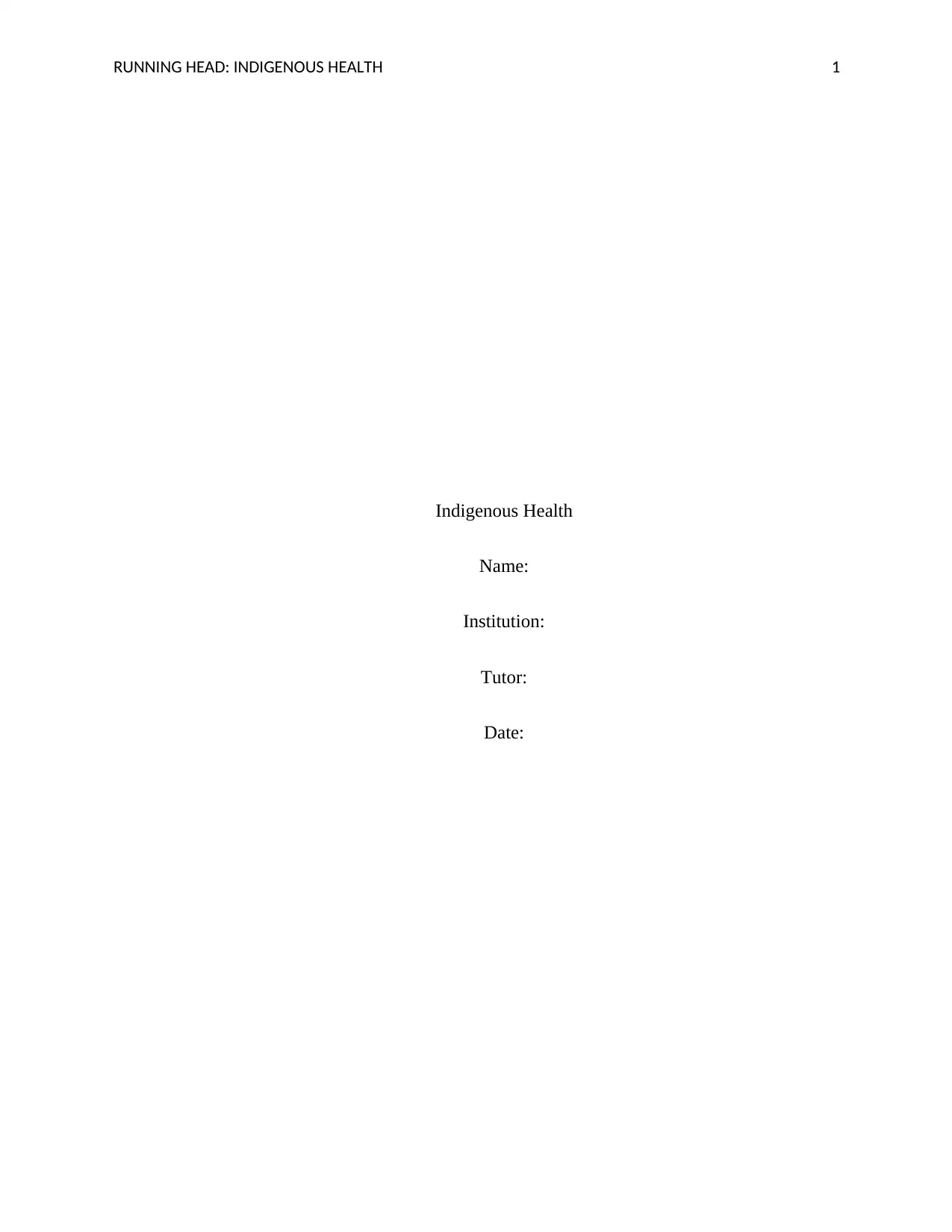
RUNNING HEAD: INDIGENOUS HEALTH 1
Indigenous Health
Name:
Institution:
Tutor:
Date:
Indigenous Health
Name:
Institution:
Tutor:
Date:
Paraphrase This Document
Need a fresh take? Get an instant paraphrase of this document with our AI Paraphraser
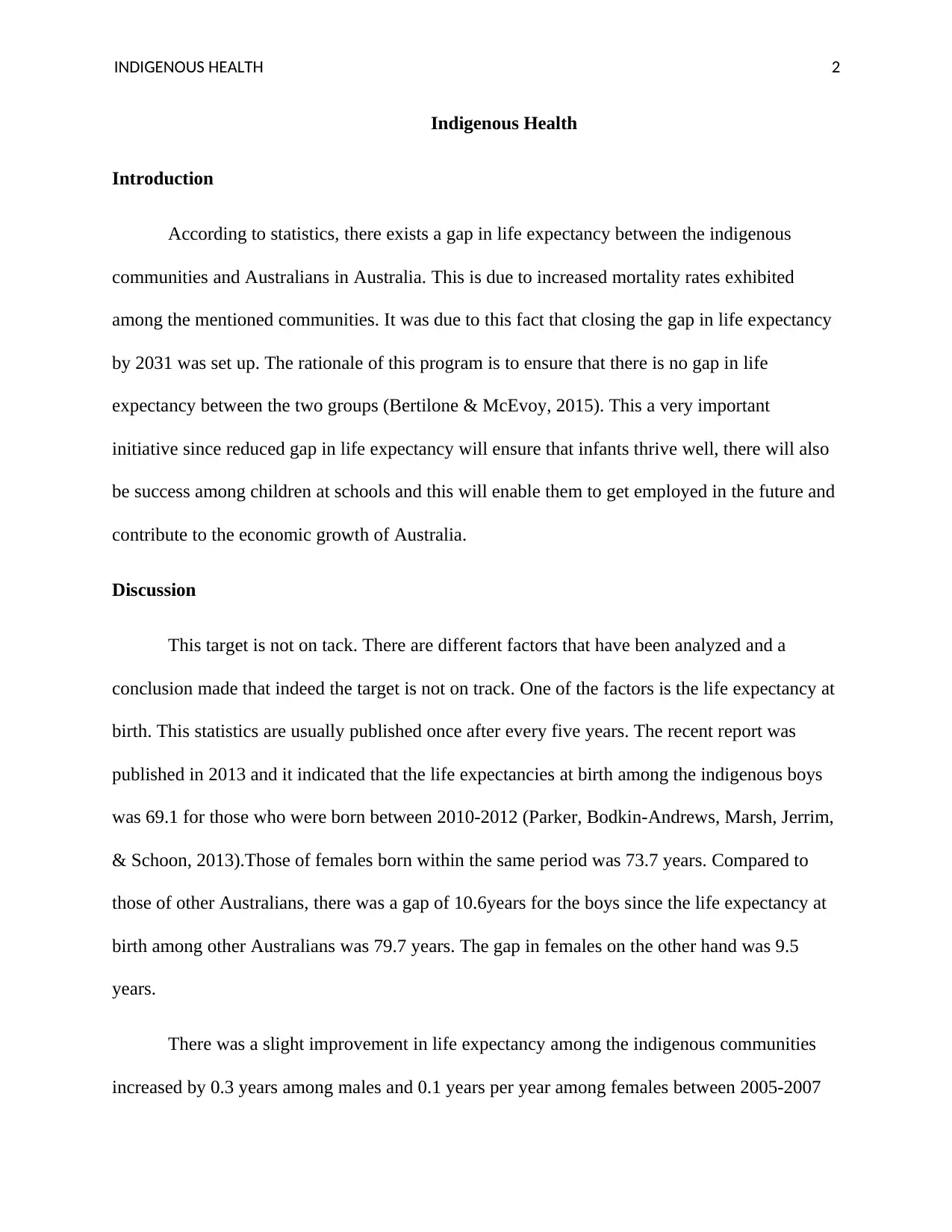
INDIGENOUS HEALTH 2
Indigenous Health
Introduction
According to statistics, there exists a gap in life expectancy between the indigenous
communities and Australians in Australia. This is due to increased mortality rates exhibited
among the mentioned communities. It was due to this fact that closing the gap in life expectancy
by 2031 was set up. The rationale of this program is to ensure that there is no gap in life
expectancy between the two groups (Bertilone & McEvoy, 2015). This a very important
initiative since reduced gap in life expectancy will ensure that infants thrive well, there will also
be success among children at schools and this will enable them to get employed in the future and
contribute to the economic growth of Australia.
Discussion
This target is not on tack. There are different factors that have been analyzed and a
conclusion made that indeed the target is not on track. One of the factors is the life expectancy at
birth. This statistics are usually published once after every five years. The recent report was
published in 2013 and it indicated that the life expectancies at birth among the indigenous boys
was 69.1 for those who were born between 2010-2012 (Parker, Bodkin-Andrews, Marsh, Jerrim,
& Schoon, 2013).Those of females born within the same period was 73.7 years. Compared to
those of other Australians, there was a gap of 10.6years for the boys since the life expectancy at
birth among other Australians was 79.7 years. The gap in females on the other hand was 9.5
years.
There was a slight improvement in life expectancy among the indigenous communities
increased by 0.3 years among males and 0.1 years per year among females between 2005-2007
Indigenous Health
Introduction
According to statistics, there exists a gap in life expectancy between the indigenous
communities and Australians in Australia. This is due to increased mortality rates exhibited
among the mentioned communities. It was due to this fact that closing the gap in life expectancy
by 2031 was set up. The rationale of this program is to ensure that there is no gap in life
expectancy between the two groups (Bertilone & McEvoy, 2015). This a very important
initiative since reduced gap in life expectancy will ensure that infants thrive well, there will also
be success among children at schools and this will enable them to get employed in the future and
contribute to the economic growth of Australia.
Discussion
This target is not on tack. There are different factors that have been analyzed and a
conclusion made that indeed the target is not on track. One of the factors is the life expectancy at
birth. This statistics are usually published once after every five years. The recent report was
published in 2013 and it indicated that the life expectancies at birth among the indigenous boys
was 69.1 for those who were born between 2010-2012 (Parker, Bodkin-Andrews, Marsh, Jerrim,
& Schoon, 2013).Those of females born within the same period was 73.7 years. Compared to
those of other Australians, there was a gap of 10.6years for the boys since the life expectancy at
birth among other Australians was 79.7 years. The gap in females on the other hand was 9.5
years.
There was a slight improvement in life expectancy among the indigenous communities
increased by 0.3 years among males and 0.1 years per year among females between 2005-2007
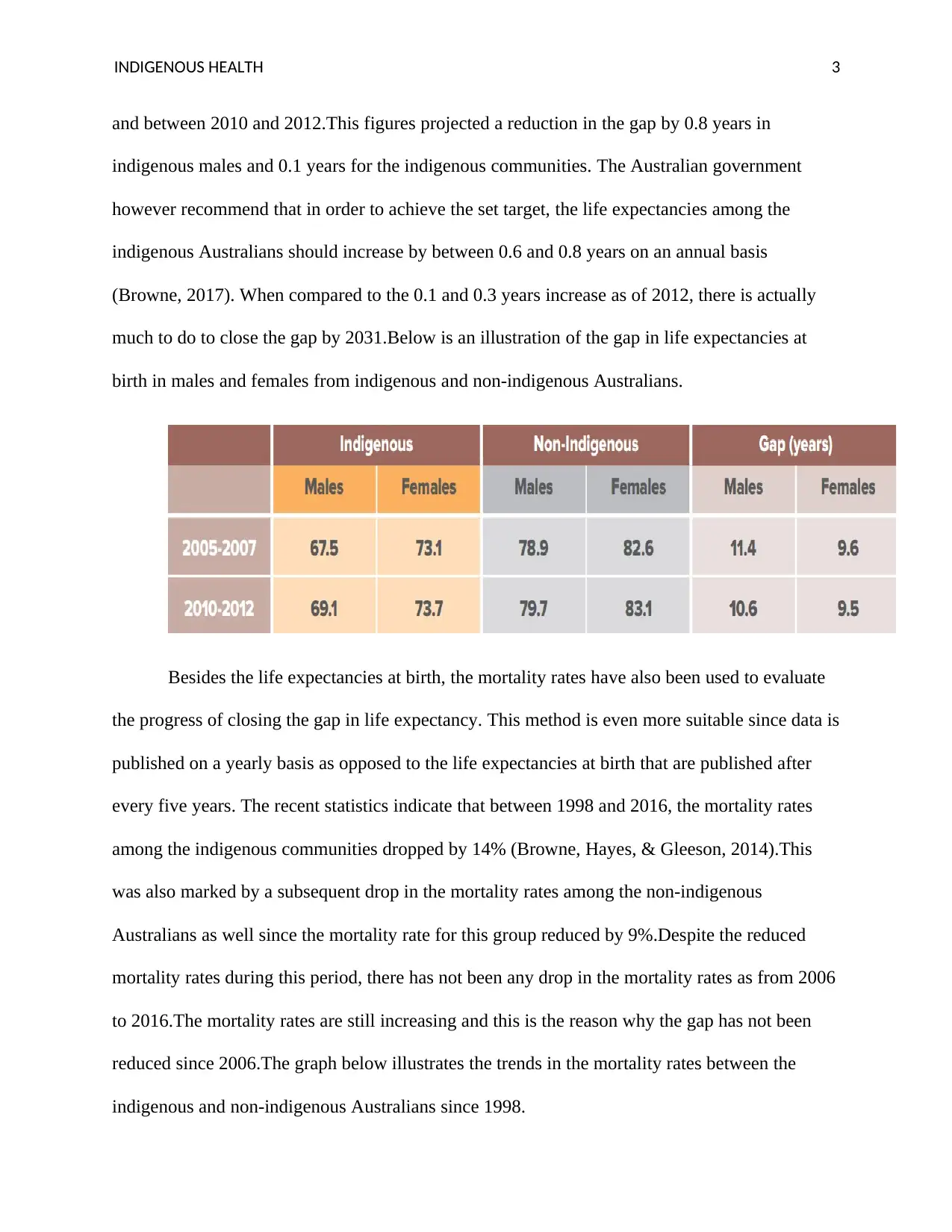
INDIGENOUS HEALTH 3
and between 2010 and 2012.This figures projected a reduction in the gap by 0.8 years in
indigenous males and 0.1 years for the indigenous communities. The Australian government
however recommend that in order to achieve the set target, the life expectancies among the
indigenous Australians should increase by between 0.6 and 0.8 years on an annual basis
(Browne, 2017). When compared to the 0.1 and 0.3 years increase as of 2012, there is actually
much to do to close the gap by 2031.Below is an illustration of the gap in life expectancies at
birth in males and females from indigenous and non-indigenous Australians.
Besides the life expectancies at birth, the mortality rates have also been used to evaluate
the progress of closing the gap in life expectancy. This method is even more suitable since data is
published on a yearly basis as opposed to the life expectancies at birth that are published after
every five years. The recent statistics indicate that between 1998 and 2016, the mortality rates
among the indigenous communities dropped by 14% (Browne, Hayes, & Gleeson, 2014).This
was also marked by a subsequent drop in the mortality rates among the non-indigenous
Australians as well since the mortality rate for this group reduced by 9%.Despite the reduced
mortality rates during this period, there has not been any drop in the mortality rates as from 2006
to 2016.The mortality rates are still increasing and this is the reason why the gap has not been
reduced since 2006.The graph below illustrates the trends in the mortality rates between the
indigenous and non-indigenous Australians since 1998.
and between 2010 and 2012.This figures projected a reduction in the gap by 0.8 years in
indigenous males and 0.1 years for the indigenous communities. The Australian government
however recommend that in order to achieve the set target, the life expectancies among the
indigenous Australians should increase by between 0.6 and 0.8 years on an annual basis
(Browne, 2017). When compared to the 0.1 and 0.3 years increase as of 2012, there is actually
much to do to close the gap by 2031.Below is an illustration of the gap in life expectancies at
birth in males and females from indigenous and non-indigenous Australians.
Besides the life expectancies at birth, the mortality rates have also been used to evaluate
the progress of closing the gap in life expectancy. This method is even more suitable since data is
published on a yearly basis as opposed to the life expectancies at birth that are published after
every five years. The recent statistics indicate that between 1998 and 2016, the mortality rates
among the indigenous communities dropped by 14% (Browne, Hayes, & Gleeson, 2014).This
was also marked by a subsequent drop in the mortality rates among the non-indigenous
Australians as well since the mortality rate for this group reduced by 9%.Despite the reduced
mortality rates during this period, there has not been any drop in the mortality rates as from 2006
to 2016.The mortality rates are still increasing and this is the reason why the gap has not been
reduced since 2006.The graph below illustrates the trends in the mortality rates between the
indigenous and non-indigenous Australians since 1998.
⊘ This is a preview!⊘
Do you want full access?
Subscribe today to unlock all pages.

Trusted by 1+ million students worldwide

INDIGENOUS HEALTH 4
The Australian Government is also improving the quality of remote housing among the
indigenous communities. Since quality housing is the foundation to closing the gap targets in
health, education as well as employment and finally community safety, the Australian
government has invested over $5.5 billion for the past 10 years to improve on the quality of
housing among the indigenous communities in Australia (Gorman & Vemuri, 2012). The number
of crowded houses has already reduced from 52-37%.
There has been increased immunization. Immunization has been on top of agenda
globally by both the United Children’s Fund and the World Health Organization in the past
decade. The Australian government has therefore increased the immunization coverage among
the Aboriginal and Torres Strait islander communities so as to close the gap by 2031.In 1997,
there was introduction of the Australia National Immunization Program so as to reduce the
overall burden of vaccine preventable infections. The response has been encouraging since in
2013, the Aboriginal and Torres Strait Islander coverage rate of immunization especially among
the 5 year old cohort has surpassed the immunization coverage rates among all the children
within the same cohort. The National Immunization Program has been providing vaccines
The Australian Government is also improving the quality of remote housing among the
indigenous communities. Since quality housing is the foundation to closing the gap targets in
health, education as well as employment and finally community safety, the Australian
government has invested over $5.5 billion for the past 10 years to improve on the quality of
housing among the indigenous communities in Australia (Gorman & Vemuri, 2012). The number
of crowded houses has already reduced from 52-37%.
There has been increased immunization. Immunization has been on top of agenda
globally by both the United Children’s Fund and the World Health Organization in the past
decade. The Australian government has therefore increased the immunization coverage among
the Aboriginal and Torres Strait islander communities so as to close the gap by 2031.In 1997,
there was introduction of the Australia National Immunization Program so as to reduce the
overall burden of vaccine preventable infections. The response has been encouraging since in
2013, the Aboriginal and Torres Strait Islander coverage rate of immunization especially among
the 5 year old cohort has surpassed the immunization coverage rates among all the children
within the same cohort. The National Immunization Program has been providing vaccines
Paraphrase This Document
Need a fresh take? Get an instant paraphrase of this document with our AI Paraphraser

INDIGENOUS HEALTH 5
against 17 different infections that can be prevented through vaccination. There has been a
general improvement of vaccination from 53-90%.
The Australian government has reduced substance misuse and harm. According to
studies, substance use is one of the leading factors that contribute to the high mortality rates
among the indigenous Australians. The government has therefore tried its best to reduce this
vice. There is the National Aboriginal and Torres Strait Islander peoples Drug strategy of 2014-
2019 that was set up to minimize the effects of illegal substances on families and communities
(Davey, 2017). The Australian Government has been funding over 80 different organizations
through Indigenous Advancement Strategy to provide indigenous specific alcohol as well as
other drug treatment services. The government has so far invested $91.5 million and 32,700
clients have so far been beneficiaries of the same.
The government has also been encouraging healthy lifestyle choices among the
indigenous Australians .This has been through the indigenous sports whereby the government
through the Indigenous Advancement Strategy, has invested more than $135 million to support
more than 151 activities so as to achieve the close the gap target (Cashman et al., 2016). The aim
of the program is to ensure that the indigenous communities in Australia engage in sports and
recreation so as to improve on their wellbeing, resilience and improve on their educational
attendance.
Control of outback stores has been another initiative still under the modification of
lifestyles. This program was set up in 2006 in response to the hardships experienced by the
indigenous communities in accessing quality as well as healthy food. The outback store regulates
food at over 36 different community stores in the Northern Territory, Western Australia and
finally the South Australia (Clifford, Doran, & Tsey, 2013). It ensures that there is quality,
against 17 different infections that can be prevented through vaccination. There has been a
general improvement of vaccination from 53-90%.
The Australian government has reduced substance misuse and harm. According to
studies, substance use is one of the leading factors that contribute to the high mortality rates
among the indigenous Australians. The government has therefore tried its best to reduce this
vice. There is the National Aboriginal and Torres Strait Islander peoples Drug strategy of 2014-
2019 that was set up to minimize the effects of illegal substances on families and communities
(Davey, 2017). The Australian Government has been funding over 80 different organizations
through Indigenous Advancement Strategy to provide indigenous specific alcohol as well as
other drug treatment services. The government has so far invested $91.5 million and 32,700
clients have so far been beneficiaries of the same.
The government has also been encouraging healthy lifestyle choices among the
indigenous Australians .This has been through the indigenous sports whereby the government
through the Indigenous Advancement Strategy, has invested more than $135 million to support
more than 151 activities so as to achieve the close the gap target (Cashman et al., 2016). The aim
of the program is to ensure that the indigenous communities in Australia engage in sports and
recreation so as to improve on their wellbeing, resilience and improve on their educational
attendance.
Control of outback stores has been another initiative still under the modification of
lifestyles. This program was set up in 2006 in response to the hardships experienced by the
indigenous communities in accessing quality as well as healthy food. The outback store regulates
food at over 36 different community stores in the Northern Territory, Western Australia and
finally the South Australia (Clifford, Doran, & Tsey, 2013). It ensures that there is quality,

INDIGENOUS HEALTH 6
healthy and affordable food among this worst hit areas. Under this program, there has been
reduced consumption of sugary food and increase in consumption of fresh fruits and juice.
Consumption of healthy food such as the fruits has reduced the mortality rates among the
indigenous communities.
There has been school nutrition programs. The government has allocated more than $24
million towards school nutrition programs especially in the Northern Territory. The aim of this
activity is to provide nutritious meals to school children. Other notable strategies include
reduction is smoking since smoking contributes to the high mortality rates among the indigenous
communities. There is also the National Disability Insurance Agency (NDIA) that assist those
indigenous individuals with disabilities (Cumming, Kinner, & Preen, 2016). There is also the
support of emotional as well as social wellbeing and the National Indigenous Critical Response
Service that responds to emergencies and suicidal cases. Finally, there is the aged care initiative
that looks after those elderly individuals within the indigenous communities.
“A people United shall never be United”. This was a quote by one of the famous leaders
in Chile known as Frederic Rzewski was to encourage people to come together in order to defeat
the enemy. I would therefore suggest that the Australian government should work in partnership
with the indigenous communities in Australia to achieve closing the gap in life expectancy by
2031.The government should fully support the Aboriginal Community Controlled Health sector
through funds. This funding will go a long way in assisting in closing the gap in life expectancy.
Conclusion
In Australia, there exists a discrepancy in life expectancy between Aboriginal and Torres
Strait islander’s people and the other Australians. Some of the factors that contribute to this gap
healthy and affordable food among this worst hit areas. Under this program, there has been
reduced consumption of sugary food and increase in consumption of fresh fruits and juice.
Consumption of healthy food such as the fruits has reduced the mortality rates among the
indigenous communities.
There has been school nutrition programs. The government has allocated more than $24
million towards school nutrition programs especially in the Northern Territory. The aim of this
activity is to provide nutritious meals to school children. Other notable strategies include
reduction is smoking since smoking contributes to the high mortality rates among the indigenous
communities. There is also the National Disability Insurance Agency (NDIA) that assist those
indigenous individuals with disabilities (Cumming, Kinner, & Preen, 2016). There is also the
support of emotional as well as social wellbeing and the National Indigenous Critical Response
Service that responds to emergencies and suicidal cases. Finally, there is the aged care initiative
that looks after those elderly individuals within the indigenous communities.
“A people United shall never be United”. This was a quote by one of the famous leaders
in Chile known as Frederic Rzewski was to encourage people to come together in order to defeat
the enemy. I would therefore suggest that the Australian government should work in partnership
with the indigenous communities in Australia to achieve closing the gap in life expectancy by
2031.The government should fully support the Aboriginal Community Controlled Health sector
through funds. This funding will go a long way in assisting in closing the gap in life expectancy.
Conclusion
In Australia, there exists a discrepancy in life expectancy between Aboriginal and Torres
Strait islander’s people and the other Australians. Some of the factors that contribute to this gap
⊘ This is a preview!⊘
Do you want full access?
Subscribe today to unlock all pages.

Trusted by 1+ million students worldwide
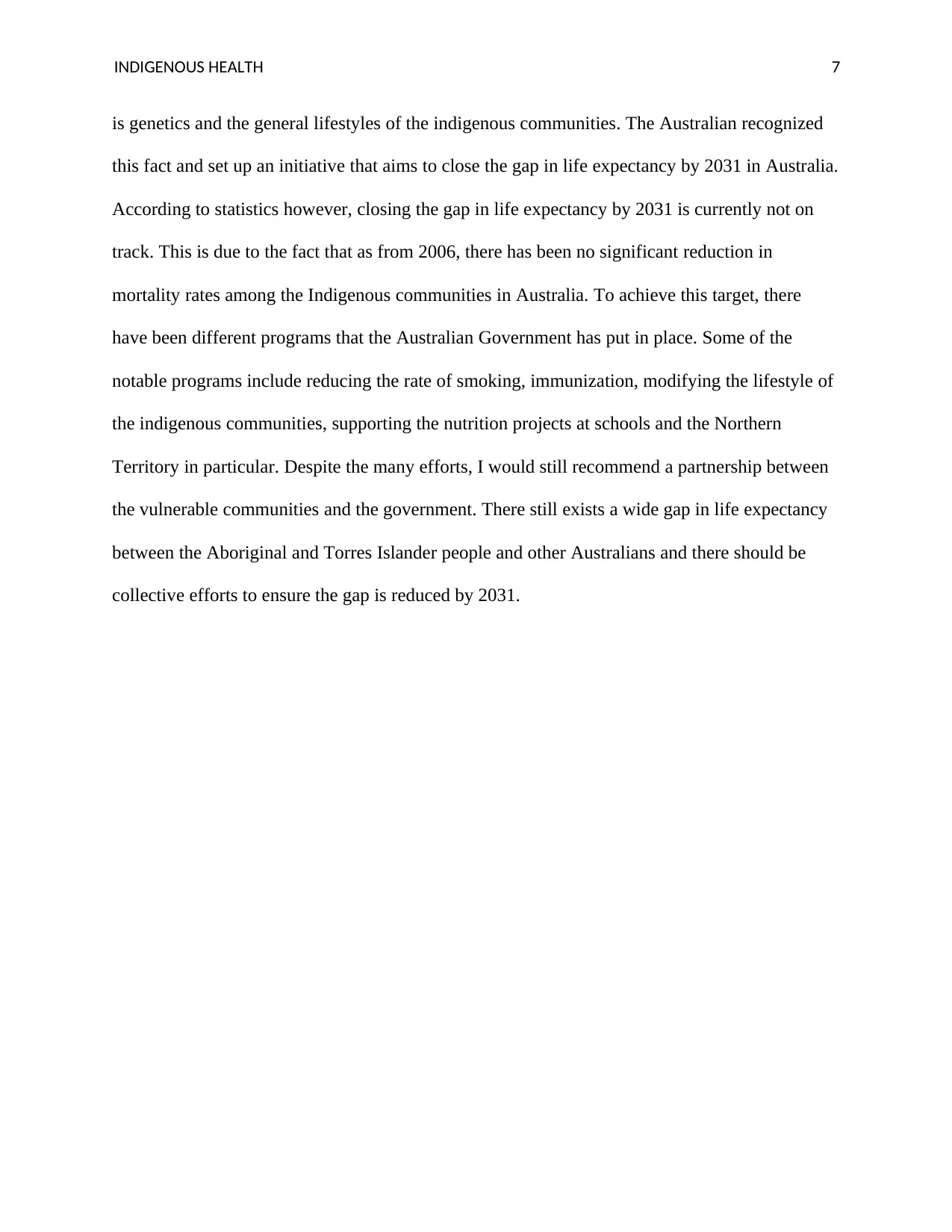
INDIGENOUS HEALTH 7
is genetics and the general lifestyles of the indigenous communities. The Australian recognized
this fact and set up an initiative that aims to close the gap in life expectancy by 2031 in Australia.
According to statistics however, closing the gap in life expectancy by 2031 is currently not on
track. This is due to the fact that as from 2006, there has been no significant reduction in
mortality rates among the Indigenous communities in Australia. To achieve this target, there
have been different programs that the Australian Government has put in place. Some of the
notable programs include reducing the rate of smoking, immunization, modifying the lifestyle of
the indigenous communities, supporting the nutrition projects at schools and the Northern
Territory in particular. Despite the many efforts, I would still recommend a partnership between
the vulnerable communities and the government. There still exists a wide gap in life expectancy
between the Aboriginal and Torres Islander people and other Australians and there should be
collective efforts to ensure the gap is reduced by 2031.
is genetics and the general lifestyles of the indigenous communities. The Australian recognized
this fact and set up an initiative that aims to close the gap in life expectancy by 2031 in Australia.
According to statistics however, closing the gap in life expectancy by 2031 is currently not on
track. This is due to the fact that as from 2006, there has been no significant reduction in
mortality rates among the Indigenous communities in Australia. To achieve this target, there
have been different programs that the Australian Government has put in place. Some of the
notable programs include reducing the rate of smoking, immunization, modifying the lifestyle of
the indigenous communities, supporting the nutrition projects at schools and the Northern
Territory in particular. Despite the many efforts, I would still recommend a partnership between
the vulnerable communities and the government. There still exists a wide gap in life expectancy
between the Aboriginal and Torres Islander people and other Australians and there should be
collective efforts to ensure the gap is reduced by 2031.
Paraphrase This Document
Need a fresh take? Get an instant paraphrase of this document with our AI Paraphraser
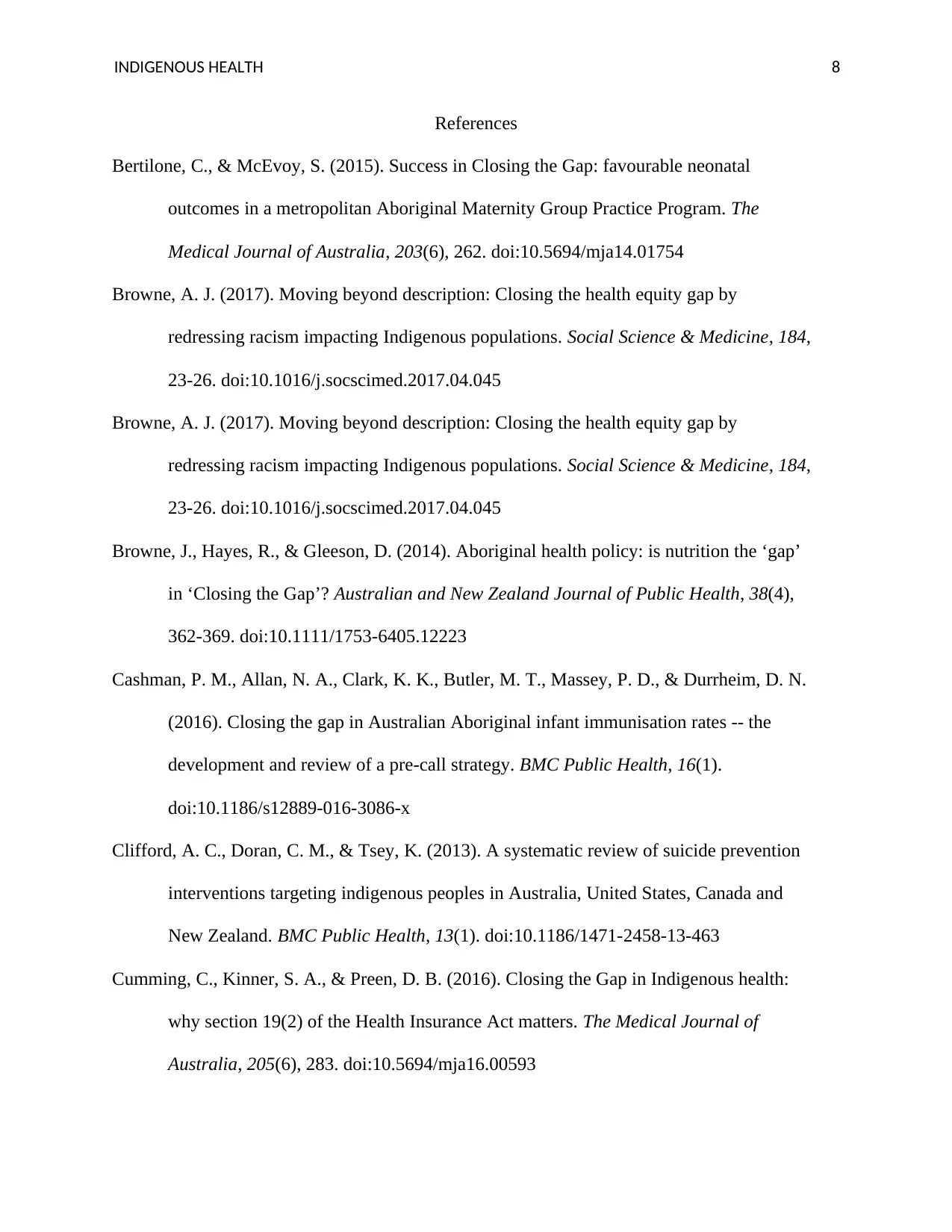
INDIGENOUS HEALTH 8
References
Bertilone, C., & McEvoy, S. (2015). Success in Closing the Gap: favourable neonatal
outcomes in a metropolitan Aboriginal Maternity Group Practice Program. The
Medical Journal of Australia, 203(6), 262. doi:10.5694/mja14.01754
Browne, A. J. (2017). Moving beyond description: Closing the health equity gap by
redressing racism impacting Indigenous populations. Social Science & Medicine, 184,
23-26. doi:10.1016/j.socscimed.2017.04.045
Browne, A. J. (2017). Moving beyond description: Closing the health equity gap by
redressing racism impacting Indigenous populations. Social Science & Medicine, 184,
23-26. doi:10.1016/j.socscimed.2017.04.045
Browne, J., Hayes, R., & Gleeson, D. (2014). Aboriginal health policy: is nutrition the ‘gap’
in ‘Closing the Gap’? Australian and New Zealand Journal of Public Health, 38(4),
362-369. doi:10.1111/1753-6405.12223
Cashman, P. M., Allan, N. A., Clark, K. K., Butler, M. T., Massey, P. D., & Durrheim, D. N.
(2016). Closing the gap in Australian Aboriginal infant immunisation rates -- the
development and review of a pre-call strategy. BMC Public Health, 16(1).
doi:10.1186/s12889-016-3086-x
Clifford, A. C., Doran, C. M., & Tsey, K. (2013). A systematic review of suicide prevention
interventions targeting indigenous peoples in Australia, United States, Canada and
New Zealand. BMC Public Health, 13(1). doi:10.1186/1471-2458-13-463
Cumming, C., Kinner, S. A., & Preen, D. B. (2016). Closing the Gap in Indigenous health:
why section 19(2) of the Health Insurance Act matters. The Medical Journal of
Australia, 205(6), 283. doi:10.5694/mja16.00593
References
Bertilone, C., & McEvoy, S. (2015). Success in Closing the Gap: favourable neonatal
outcomes in a metropolitan Aboriginal Maternity Group Practice Program. The
Medical Journal of Australia, 203(6), 262. doi:10.5694/mja14.01754
Browne, A. J. (2017). Moving beyond description: Closing the health equity gap by
redressing racism impacting Indigenous populations. Social Science & Medicine, 184,
23-26. doi:10.1016/j.socscimed.2017.04.045
Browne, A. J. (2017). Moving beyond description: Closing the health equity gap by
redressing racism impacting Indigenous populations. Social Science & Medicine, 184,
23-26. doi:10.1016/j.socscimed.2017.04.045
Browne, J., Hayes, R., & Gleeson, D. (2014). Aboriginal health policy: is nutrition the ‘gap’
in ‘Closing the Gap’? Australian and New Zealand Journal of Public Health, 38(4),
362-369. doi:10.1111/1753-6405.12223
Cashman, P. M., Allan, N. A., Clark, K. K., Butler, M. T., Massey, P. D., & Durrheim, D. N.
(2016). Closing the gap in Australian Aboriginal infant immunisation rates -- the
development and review of a pre-call strategy. BMC Public Health, 16(1).
doi:10.1186/s12889-016-3086-x
Clifford, A. C., Doran, C. M., & Tsey, K. (2013). A systematic review of suicide prevention
interventions targeting indigenous peoples in Australia, United States, Canada and
New Zealand. BMC Public Health, 13(1). doi:10.1186/1471-2458-13-463
Cumming, C., Kinner, S. A., & Preen, D. B. (2016). Closing the Gap in Indigenous health:
why section 19(2) of the Health Insurance Act matters. The Medical Journal of
Australia, 205(6), 283. doi:10.5694/mja16.00593
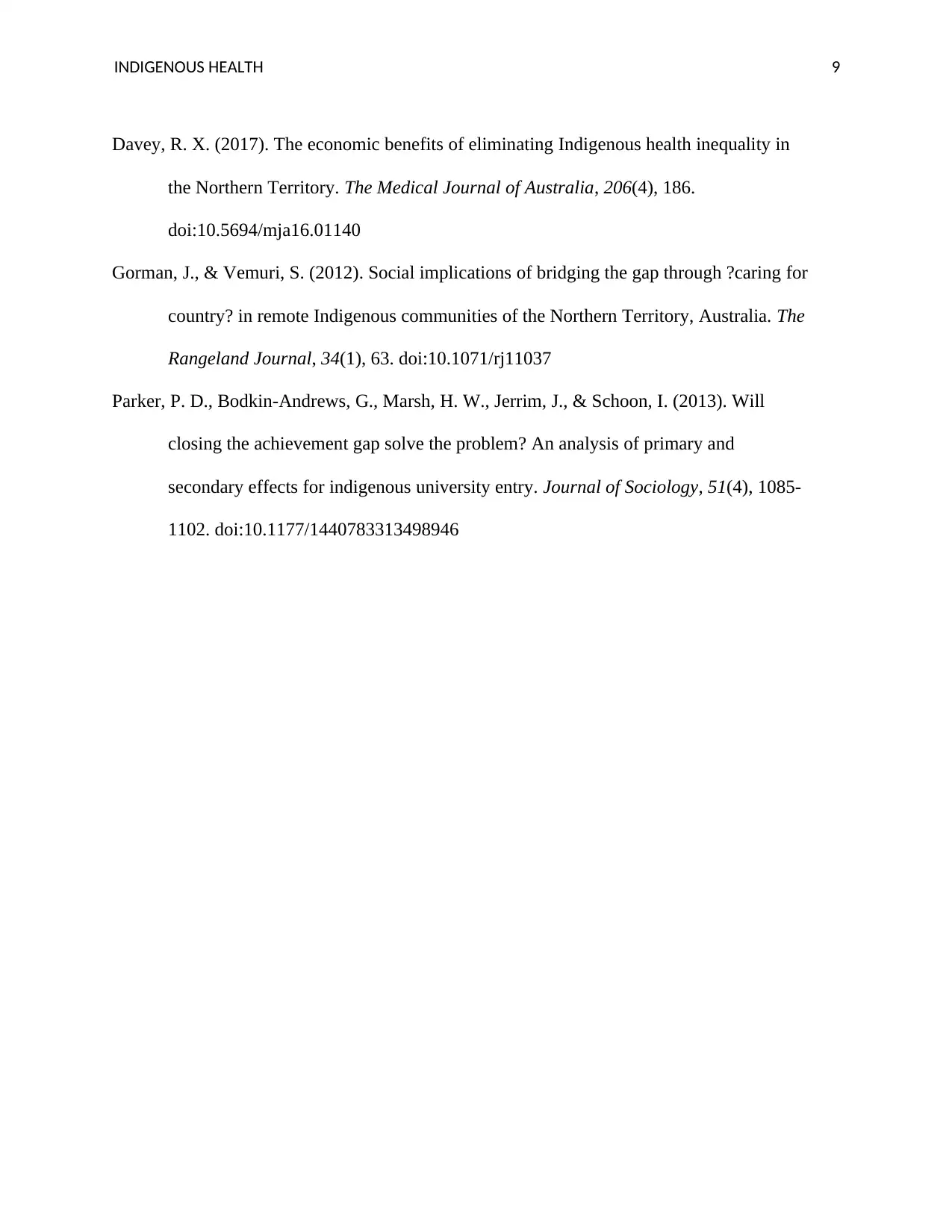
INDIGENOUS HEALTH 9
Davey, R. X. (2017). The economic benefits of eliminating Indigenous health inequality in
the Northern Territory. The Medical Journal of Australia, 206(4), 186.
doi:10.5694/mja16.01140
Gorman, J., & Vemuri, S. (2012). Social implications of bridging the gap through ?caring for
country? in remote Indigenous communities of the Northern Territory, Australia. The
Rangeland Journal, 34(1), 63. doi:10.1071/rj11037
Parker, P. D., Bodkin-Andrews, G., Marsh, H. W., Jerrim, J., & Schoon, I. (2013). Will
closing the achievement gap solve the problem? An analysis of primary and
secondary effects for indigenous university entry. Journal of Sociology, 51(4), 1085-
1102. doi:10.1177/1440783313498946
Davey, R. X. (2017). The economic benefits of eliminating Indigenous health inequality in
the Northern Territory. The Medical Journal of Australia, 206(4), 186.
doi:10.5694/mja16.01140
Gorman, J., & Vemuri, S. (2012). Social implications of bridging the gap through ?caring for
country? in remote Indigenous communities of the Northern Territory, Australia. The
Rangeland Journal, 34(1), 63. doi:10.1071/rj11037
Parker, P. D., Bodkin-Andrews, G., Marsh, H. W., Jerrim, J., & Schoon, I. (2013). Will
closing the achievement gap solve the problem? An analysis of primary and
secondary effects for indigenous university entry. Journal of Sociology, 51(4), 1085-
1102. doi:10.1177/1440783313498946
⊘ This is a preview!⊘
Do you want full access?
Subscribe today to unlock all pages.

Trusted by 1+ million students worldwide
1 out of 9
Related Documents
Your All-in-One AI-Powered Toolkit for Academic Success.
+13062052269
info@desklib.com
Available 24*7 on WhatsApp / Email
![[object Object]](/_next/static/media/star-bottom.7253800d.svg)
Unlock your academic potential
Copyright © 2020–2025 A2Z Services. All Rights Reserved. Developed and managed by ZUCOL.



